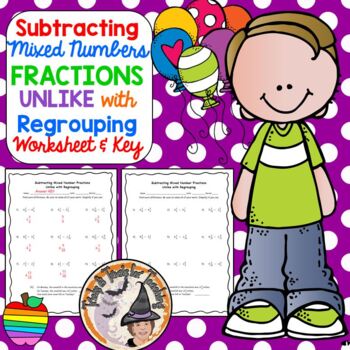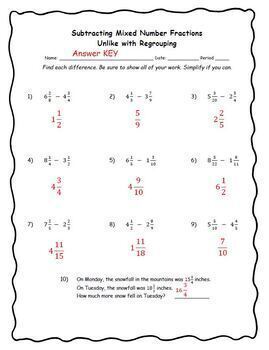Subtracting Mixed Number Fractions with Regrouping Worksheet and Answer KEY
Tricks and Treats for Teaching
733 Followers
Grade Levels
4th - 7th, Homeschool, Staff
Subjects
Resource Type
Standards
CCSS4.NF.A.1
CCSS4.NF.A.2
CCSS4.NF.B.3a
CCSS4.NF.B.3b
CCSS5.NF.A.1
Formats Included
- Zip
Pages
2 pages
Tricks and Treats for Teaching
733 Followers
What educators are saying
I am using this resource again this year with my students that need extra practice subtracting fractions that require regrouping.
I loved this resource. It was great review for my students and you can also use it for homework. My students found it helpful as well.
Also included in
- Teachers ~ this SUPER Fractions-Worksheet-BUNDLE is EVERYTHING you need for teaching adding, subtracting, mixed numbers, regrouping, from a whole number, renaming, borrowing, multiplying, and dividing. These are my FAVORITE independent practice pages for my math students. GREAT for spiraling conceptPrice $11.75Original Price $15.75Save $4.00
Description
Subtract Mixed-Number Fractions with Unlike-Denominators with-Regrouping-Worksheet has a mix of computation problems, along with a word problem. Terrific to assess students' knowledge of subtracting fractions when regrouping, borrowing, and renaming. Answer KEY included. You'll enjoy using this year after year.
IF YOU WOULD LIKE THE VERSION THAT INCLUDES DIGITAL CLICK HERE:
Be sure to L@@K at my other 1,285+ TERRIFIC teaching resources!
~ ~ THANK YOU KINDLY ~ ~
Total Pages
2 pages
Answer Key
Included
Teaching Duration
N/A
Report this resource to TPT
Reported resources will be reviewed by our team. Report this resource to let us know if this resource violates TPT’s content guidelines.
Standards
to see state-specific standards (only available in the US).
CCSS4.NF.A.1
Explain why a fraction 𝘢/𝘣 is equivalent to a fraction (𝘯 × 𝘢)/(𝘯 × 𝘣) by using visual fraction models, with attention to how the number and size of the parts differ even though the two fractions themselves are the same size. Use this principle to recognize and generate equivalent fractions.
CCSS4.NF.A.2
Compare two fractions with different numerators and different denominators, e.g., by creating common denominators or numerators, or by comparing to a benchmark fraction such as 1/2. Recognize that comparisons are valid only when the two fractions refer to the same whole. Record the results of comparisons with symbols >, =, or <, and justify the conclusions, e.g., by using a visual fraction model.
CCSS4.NF.B.3a
Understand addition and subtraction of fractions as joining and separating parts referring to the same whole.
CCSS4.NF.B.3b
Decompose a fraction into a sum of fractions with the same denominator in more than one way, recording each decomposition by an equation. Justify decompositions, e.g., by using a visual fraction model. Examples: 3/8 = 1/8 + 1/8 + 1/8; 3/8 = 1/8 + 2/8; 2 1/8 = 1 + 1 + 1/8 = 8/8 + 8/8 + 1/8.
CCSS5.NF.A.1
Add and subtract fractions with unlike denominators (including mixed numbers) by replacing given fractions with equivalent fractions in such a way as to produce an equivalent sum or difference of fractions with like denominators. For example, 2/3 + 5/4 = 8/12 + 15/12 = 23/12. (In general, 𝘢/𝘣 + 𝘤/𝘥 = (𝘢𝘥 + 𝘣𝘤)/𝘣𝘥.)






